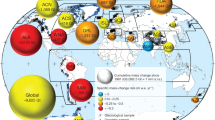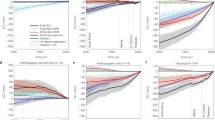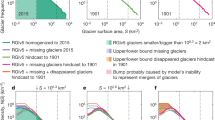Abstract
The large uncertainty in future global glacier volume projections partly results from a substantial range in future climate conditions projected by global climate models. This study addresses the effect of global and regional differences in climate input data on the projected twenty-first century glacier contribution to sea-level rise. Glacier volume changes are calculated with a surface mass balance model combined with volume-area scaling, applied to 89 glaciers in different climatic regions. The mass balance model is based on a simplified energy balance approach, with separated contributions by net solar radiation and the combined other fluxes. Future mass balance is calculated from anomalies in air temperature, precipitation and atmospheric transmissivity, taken from eight global climate models forced with the A1B emission scenario. Regional and global sea-level contributions are obtained by scaling the volume changes at the modelled glaciers to all glaciers larger than 0.1 km2 outside the Greenland and Antarctic ice sheets. This results in a global value of 0.102 ± 0.028 m (multi-model mean and standard deviation) relative sea-level equivalent for the period 2012–2099, corresponding to 18 ± 5 % of the estimated total volume of glaciers. Glaciers in the Antarctic, Alaska, Central Asia and Greenland together account for 65 ± 4 % of the total multi-model mean projected sea-level rise. The projected sea-level contribution is 35 ± 17 % larger when only anomalies in air temperature are taken into account, demonstrating an important compensating effect by increased precipitation and possibly reduced atmospheric transmissivity. The variability in projected precipitation and atmospheric transmissivity changes is especially large in the Arctic regions, making the sea-level contribution for these regions particularly sensitive to the climate model used. Including additional uncertainties in the modelling procedure and the input data, the total uncertainty estimate for the future projections becomes ±0.063 m.










Similar content being viewed by others
References
Arendt A, 77 others (2012) Randolph glacier inventory [v1.0]: a dataset of global glacier outlines. http://www.glims.org/RGI. Global Land Ice Measurements from Space, Boulder Colorado, USA
Bahr DB (1997) Global distributions of glacier properties: a stochastic scaling paradigm. Water Resour Res 33:1669–1679
Bahr DB, Meier MF, Peckham SD (1997) The physical basis of glacier volume-area scaling. J Geophys Res 102(B9):20355–20362
Bliss A, Hock R, Cogley JG (2013) A new inventory of mountain glaciers and ice caps for the Antarctic periphery. Ann Glaciol 54:191–199. doi:10.3189/2013AoG63A377
Chen J, Ohmura A (1990) Estimation of Alpine glacier water resources and their change since the 1870s. IAHS Publ 193:127–135
Chinn T, Winkler S, Salinger MJ, Haakensen N (2005) Recent glacier advances in Norway and New Zealand: a comparison of their glaciological and meteorological causes. Geogr Ann 87A:141–157
Cogley JG (2009a) A more complete version of the World Glacier Inventory. Ann Glaciol 50:32–38
Cogley JG (2009b) Geodetic and direct mass-balance measurements: comparison and joint analysis. Ann Glaciol 50:96–100
de Woul M, Hock R (2005) Static mass-balance sensitivity of Arctic glaciers and ice caps using a degree-day approach. Ann Glaciol 42:217–224
Dee DP, 35 others (2011) The ERA-Interim reanalysis: configuration and performance of the data assimilation system. Q J R Meteorol Soc 137(656):553–597. doi:10.1002/qj.828
Dyurgerov MB (2010) Reanalysis of glacier changes: from the IGY to the IPY, 1960–2008. Data of Glaciological Studies, Publication 108, Moscow
Ettema J, van den Broeke MR, van Meijgaard E, van den Berg WJ, Bamber JL, Box JE, Bales RC (2009) Higher surface mass balance of the Greenland ice sheet revealed by high-resolution climate modeling. Geophys Res Lett 36(L12501). doi:10.1029/2009GL038110
Giesen RH, Oerlemans J (2010) Response of the ice cap Hardangerjøkulen in southern Norway to the 20th and 21st century climates. Cryosphere 4:191–213. doi:10.5194/tc-4-191-2010
Giesen RH, Oerlemans J (2012) Calibration of a surface mass balance model for global-scale applications. Cryosphere 6:1463–1481. doi:10.5194/tc-6-1463-2012
Heikkilä U, Sandvik A, Sorteberg A (2011) Dynamical downscaling of ERA-40 in complex terrain using the WRF regional climate model. Clim Dyn 37:1551–1564. doi:10.1007/s00382-010-0928-6
Huss M, Jouvet G, Farinotti D, Bauder A (2010) Future high-mountain hydrology: a new parameterization of glacier retreat. Hydrol Earth Syst Sci 14:815–829. doi:10.5194/hess-14-815-2010
Immerzeel WW, van Beek LPH, Konz M, Shrestha AB, Bierkens MFP (2012) Hydrological response to climate change in a glacierized catchment in the Himalayas. Clim Change 110:721–736. doi:10.1007/s10584-011-0143-4
IPCC (2007) Climate change 2007: the physical science basis. In: Solomon S, Qin D, Manning M, Chen Z, Marquis M, Averyt KB, Tignor M, Miller HL (eds) Contribution of working group I to the 4th assessment report of the intergovernmental panel on climate change. Cambridge University Press, Cambridge
Jacob T, Wahr J, Pfeffer WT (2012) Recent contributions of glaciers and ice caps to sea level rise. Nature 482:514–518. doi:10.1038/nature10847
Landerer FW, Jungclaus JH, Marotzke J (2007) Regional dynamic and steric sea level change in response to the IPCC-A1B scenario. J Phys Oceanogr 37:296–312. doi:10.1175/JPO3013.1
Marzeion B, Jarosch AH, Hofer M (2012) Past and future sea-level change from the surface mass balance of glaciers. Cryosphere 6(6):1295–1322. doi:10.5194/tc-6-1295-2012
Meehl GA, Covey C, Delworth T, Latif M, McAvaney B, Mitchell JFB, Stouffer RJ, Taylor KE (2007) The WCRP CMIP3 multi-model dataset: a new era in climate change research. Bull Am Meteorol Soc 88:1383–1394
Mihalcea C, Mayer C, Diolaiuti G, D’Agata C, Smiraglia C, Lambrecht A, Vuillermoz E, Tartari G (2008) Spatial distribution of debris thickness and melting from remote-sensing and meteorological data, at debris-covered Baltoro glacier, Karakoram, Pakistan. Ann Glaciol 48:49–57
Mitchell TD, Jones PD (2005) An improved method of constructing a database of monthly climate observations and associated high-resolution grids. Int J Clim 25:693–712
Nakicenovic N, 27 others (2000) IPCC special report on emissions scenarios. Cambridge University Press, Cambridge
New M, Lister D, Hulme M, Makin I (2002) A high-resolution data set of surface climate over global land areas. Clim Res 21:1–25
Oerlemans J (1991) The mass balance of the Greenland ice sheet: sensitivity to climate change as revealed by energy-balance modelling. Holocene 1:40–49
Oerlemans J, Knap WH (1998) A 1 year record of global radiation and albedo in the ablation zone of Morteratschgletscher, Switzerland. J Glaciol 44:231–238
Oerlemans J, Bassford RP, Chapman W, Dowdeswell JA, Glazovsky AF, Hagen JO, Melvold K, de Ruyter de Wildt M, van de Wal RSW (2005) Estimating the contribution of Arctic glaciers to sea-level change in the next 100 years. Ann Glaciol 42:230–236
Oerlemans J, Giesen RH, van den Broeke MR (2009) Retreating alpine glaciers: increased melt rates due to accumulation of dust (Vadret da Morteratsch, Switzerland). J Glaciol 55:729–736
Pardaens AK, Gregory JM, Lowe JA (2010) A model study of factors influencing projected changes in regional sea level over the twenty-first century. Clim Dyn 36:2015–2033. doi:10.1007/s00382-009-0738-x
Paul F, Kääb A, Maisch M, Kellenberger T, Haeberli W (2004) Rapid disintegration of Alpine glaciers observed with satellite data. Geophys Res Lett 31(L21402). doi:10.1029/2004GL020816
Pelto MS (2006) The current disequilibrium of North Cascade glaciers. Hydrol Proc 20(4):769–779. doi:10.1002/hyp.6132
Radić V, Hock R (2010) Regional and global volumes of glaciers derived from statistical upscaling of glacier inventory data. J Geophys Res 115(F01010). doi:10.1029/2009JF001373
Radić V, Hock R (2011) Regionally differentiated contribution of mountain glaciers and ice caps to future sea-level rise. Nat Geosci 4:91–94. doi:10.1038/NGEO1052
Raper SCB, Braithwaite RJ (2006) Low sea level rise projections from mountain glaciers and icecaps under global warming. Nature 439:311–313. doi:10.1038/nature04448
Rasmussen LA, Conway H (2005) Influence of upper-air conditions on glaciers in Scandinavia. Ann Glaciol 42:402–408
Scherler D, Bookhagen B, Strecker MR (2011) Spatially variable response of Himalayan glaciers to climate change affected by debris cover. Nat Geosci 4:156–159. doi:10.1038/ngeo1068
Slangen ABA, van de Wal RSW (2011) An assessment of uncertainties in using volume-area modelling for computing the twenty-first century glacier contribution to sea-level change. Cryosphere 5:673–686. doi:10.5194/tc-5-673-2011
Slangen ABA, Katsman CA, van de Wal RSW, Vermeersen LLA, Riva REM (2012) Towards regional projections of twenty-first century sea-level change based on IPCC SRES scenarios. Clim Dyn 38:1191–1209. doi:10.1007/s00382-011-1057-6
Stahl K, Moore RD, Shea JM, Hutchinson D, Cannon AJ (2008) Coupled modelling of glacier and streamflow response to future climate scenarios. Water Resour Res 44(W02422). doi:10.1029/2007WR005956
Urrutia R, Vuille M (2009) Climate change projections for the tropical Andes using a regional climate model: temperature and precipitation simulations for the end of the 21st century. J Geophys Res 114(D02108). doi:10.1029/2008JD011021
World Glacier Monitoring Service (WGMS) (1999, updated 2012) World Glacier Inventory, Antarctica. doi:10.7265/N5/NSIDC-WGI-2012-02, National Snow and Ice Data Center, Boulder Colorado, USA
Zemp M, Nussbaumer SU, Gärtner-Roer I, Hoelzle M, Paul F, Haeberli W (eds) (2011) Glacier mass balance bulletin no. 11 (2008–2009). ICSU(WDS)/IUGG(IACS)/UNEP/UNESCO/WMO, World Glacier Monitoring Service, Zurich, Switzerland
Acknowledgments
We like to thank M. Zemp for providing the glacier mass balance data and the numerous contributors for submitting their measurements to WGMS. The CRU and ECMWF are acknowledged for making their datasets available. We acknowledge the modeling groups, the Program for Climate Model Diagnosis and Intercomparison (PCMDI) and the WCRP’s Working Group on Coupled Modelling (WGCM) for their roles in making available the WCRP CMIP3 multi-model dataset. We are grateful to F. Paul, T. Bolch and P. Rastner for their help with the glacier inventory and thank A. Bliss for providing the complete inventory for Antarctica. H. Machguth and M. Schaefer are thanked for providing additional glacier data and A. Slangen is thanked for providing her model results. We like to thank three anonymous reviewers for their constructive comments which helped to improve the manuscript. We acknowledge the ice2sea project, funded by the European Commission’s 7th Framework Programme through grant number 226375, ice2sea manuscript number 133.
Author information
Authors and Affiliations
Corresponding author
Rights and permissions
About this article
Cite this article
Giesen, R.H., Oerlemans, J. Climate-model induced differences in the 21st century global and regional glacier contributions to sea-level rise. Clim Dyn 41, 3283–3300 (2013). https://doi.org/10.1007/s00382-013-1743-7
Received:
Accepted:
Published:
Issue Date:
DOI: https://doi.org/10.1007/s00382-013-1743-7




